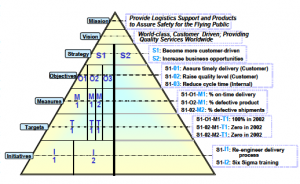A Balanced Scorecard for the Cloud
 You’ve probably experienced a derivative of Balanced Scorecard (Balanced Scorecard Management or BSM) if you’ve ever strategized, or simply thought about the forest as well as the trees. Howard Rohm, Vice-President of the Balanced Scorecard Institute, definitely has.
You’ve probably experienced a derivative of Balanced Scorecard (Balanced Scorecard Management or BSM) if you’ve ever strategized, or simply thought about the forest as well as the trees. Howard Rohm, Vice-President of the Balanced Scorecard Institute, definitely has.
BSM, as the Institute has described it, is a strategic management tool for measuring whether the smaller-scale operational activities of a company are aligned with its larger-scale objectives in terms of vision and strategy.
In balanced scorecard language, vision, mission, and strategy at the corporate level are decomposed into different views, or perspectives, as seen through the eyes of business owners, customers and other stakeholders, managers and process owners, and employees.
Balanced Scorecard in the Clouds?
Lets start by saying that you have the following mission for a company, which simply defines the ‘Purpose, reason for being’, or ‘Who we are and what we do’:
Our Mission is to be a trusted provider of information systems using highly innovative software technology that contributes to the development of society.
Lets expand this with the vision for the company, which can be defined as an ‘Image of the future we seek to create’:
Our Vision is to make the Internet even more accessible by using proprietary and innovative software technologies leveraging open source, collaboration, and the web.
OK. Now comes the strategy. Lets introduce cloud…Cloud Computing is core Information Technology that is predicted to make a disruptive impact on the development of society by leveraging open source, collaborative applications, and, of course, the web. So, in short, “Cloud is the strategy”! I quote a colleague of mine in my last life in online digital media and SaaS, J.D. Lasica:
Over time, the cloud will transform our approach to such fundamental concepts as search, commerce, money and security on a global basis.
Google CEO, Eric Schmidt, has called this “the cloud computing age.” Oracle CEO, Larry Ellison, declared that the network would become the computer, and many people now refer to the emerging next-generation Internet as “the cloud.”
As we’ve seen, Cloud can be an awfully broad category (just look at my ecosystem blog entries). But no matter what piece of the Cloud puzzle you propose to offer, the question for any organization is, “how do you make sure the details of your cloud strategy match up with the tactics of the greater organization?” or “How do we make sure the cloud strategy is the approach used to accomplish the mission and implement an organization’s vision?”
This is where BSM comes in.
 Cloud BSM Step 1
Cloud BSM Step 1
Step one is an assessment of the organization’s foundations, its core beliefs, market opportunities, competition, financial position, short- and long-term goals, and, MOST IMPORTANTLY, an understanding of what satisfies its current and future customers (needs analysis) as it applies to cloud.
This can be performed with a simple off-site meeting where the management team develops, discusses, and documents the organization’s strengths, weaknesses, opportunities, and threats.
 Cloud BSM Step 2
Cloud BSM Step 2
Step two is the development of overall business strategy. This can be both at a high-level as well as a very detailed level. For example, the high-level strategy may be:
To create cloud-based collaborative applications that capture X million end-users within Y years.
The business strategy could then dive deeper. For example:
Provide leading Internet Identity Security, delivering both on-premise software and on-demand services for Internet Single Sign-On (SSO), Identity-Enabled Web Services and Internet User Account Management for both the consumer and enterprise customers.
The strategy is a hypothesis of what we think will work and be successful. Some can conceive of this based purely on “gut”, and others derive it from significant industry, customer, and competitive analysis. I believe this process has to be driven by: 1) customer need, and 2) competitive landscape.
 Cloud BSM Step 3
Cloud BSM Step 3
Step three is a decomposition of business strategy into smaller components, called objectives. Objectives are the basic building blocks of strategy at all levels of the organization – the components or activities that make up complete business strategies.
I prefer to define SMART metrics that make up objectives (SMART stands for Specific, Measurable, Actionable, Realistic, and Timely). I believe objectives have to be tied to metrics that define the performance of each department of the business (marketing, sales, business development, engineering, operations, HR, finance, etc.), and then, in turn, down to the individual.
Howard Rohm likes to map the strategy and associated metrics to four BSM areas: Financial, Customer, Internal Processes, and Learning/Growth. It’s not unreasonable to make sure that these four aspects of the business are represented within company, department, and individual objectives, but I prefer to map to functional areas of the business first. Call it KMBSM (Kaskade Modified BSM).
Other Outputs of BSM
You can then take the output of this process and use it to build an Operating Plan for the company (the objectives, metrics with targets, and a revenue/expense plan.) This result coupled with the details of all analysis that went into the formulation can be compiled to create the Company’s Business Plan. Some companies like to have a specific Marketing & Sales or Go-To-Market Plan as well (this will detail direct vs. indirect channels, partnerships, pricing, sales tactics, service/warranty, advertising/promotion). Complex engineering projects not only require a product requirements document (PRD), but an overall Engineering Development Plan (consisting mainly of a project plan broken down by tasks, durations, resources, etc.). All this for another post 😉
Interested in platforms that support the Enterprise’s ability to manage this exercise? Try Mindtouch‘s collaborative platform for the enterprise here.



